Constant Change: Reforms of the Bundeswehr
Armed forces must continue to change in order to meet new challenges. To this end, the Bundeswehr has been reformed many times.
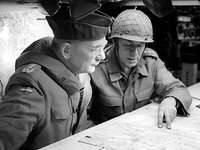


Armed forces must continue to change in order to meet new challenges. To this end, the Bundeswehr has been reformed many times.

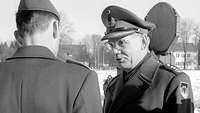
Ulrich de Maizière, Chief of Defence at that time – his name is inextricably linked to the concept of leadership development and civic education.
Bundeswehr/Günther OedThe Bundeswehr’s first reform started as soon as it was established. The guiding principle of the “citizen in uniform” and the concept of leadership development and civic education represented a radical break with the identity of military personnel in earlier German armies. Soldiers were now expected to be more than just military professionals. As responsible citizens, they were no longer supposed to exercise the same blind obedience as in past times.
Since then, people in the Bundeswehr have had the same rights as those not serving in it. Members of the Bundeswehr are neither apolitical mercenaries, nor are they expected to fully identify with a single political view. They are only bound by the Basic Law for the Federal Republic of Germany and by the provisions of international law.
Other than that, change is the only constant. This is and has been especially true of the Bundeswehr, even in its history before 1990. New weapon systems were introduced, and the length of military service changed repeatedly. Starting in the mid-1960s, financial shortages in the federal budget also led to downsizing of the armed forces.
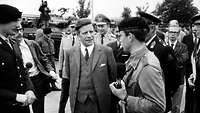
Federal Minister of Defence Helmut Schmidt saw a need for education and professional qualifications for officers and noncommissioned officers in the Bundeswehr.
Bundeswehr/MenkeCompulsory military service brought more than ten million German citizens to the Bundeswehr, most of them as conscripts. Some enlisted as temporary-career volunteers and career service members. Many of them had university entrance qualifications or had completed vocational training.
Helmut Schmidt, Federal Minister of Defence from 1969 to 1972, recognised that officers and noncommissioned officers needed professional qualifications, and not just for after their time in the Bundeswehr.
He also realised that superior officers needed more education. Courses at service schools were introduced for noncommissioned officers, along with masterclasses for senior noncommissioned officers. As of 1974, officers were required to complete academic studies at one of the two Bundeswehr universities, either in Munich or Hamburg.
A new era for the Bundeswehr began in 1990. After German reunification, the personnel staffing level was reduced considerably, to 370,000 men and women. The previous division into the territorial army and the Army in the field was eliminated. The Air Force and the Navy reduced their supply of weapons to the types that seemed viable for the future. For the first time, the number of Bundeswehr locations decreased dramatically. However, the division of the forces into main defence forces and fully manned and equipped crisis response forces, which was ordered by Volker Rühe, then Federal Minister of Defence, led to complaints of a “two-class army” because of the differences in material resources.
Only after the change of government in 1998 was a thorough analysis conducted as to what the Bundeswehr needed to be capable of and how it had to be structured in order to meet these requirements. From 1999 to 2000, the commission on “Common Security and the Future of the Bundeswehr”, led by former Federal President Richard von Weizsäcker, analysed Germany’s security objectives and the necessary armed forces structures to achieve them. However, its proposals for the Bundeswehr’s armed forces structure and personnel structure were not fully implemented. Instead, the proposals developed during the same period by the Federal Ministry of Defence’s Policy Planning Staff played a key role. As a result, the Joint Support and Enabling Service was formed as a fourth major military organisational element along with the Army, Air Force and Navy. The Joint Support and Enabling Service consolidates joint and common tasks such as logistics, communications and military police. Non-military support services, such as the use of motor vehicles that do not need to be militarised, were outsourced to civilian companies.
In the years that followed, the Bundeswehr was reduced to 250,000 military personnel, military service was shortened to six months, and voluntary military service for up to 23 months was introduced.
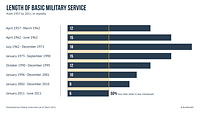
Basic military service lasted from six to eighteen months. The length was determined by the number of people born in a particular year and by the current threat situation.
Bundeswehr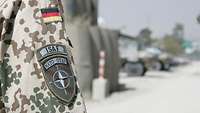
The Bundeswehr went from an army for national defence to an army on operations. The ISAFInternational Security Assistance Force mission is one example.
Bundeswehr/Andrea BienertAnother restructuring process began in 2002 in order to improve the Bundeswehr’s operational capability. It was known as the transformation of the Bundeswehr.
The focus was now on the Bundeswehr’s operations abroad, especially in Afghanistan. Its original core mission of national and collective defence increasingly took a back seat to these operations. The armed forces’ new tasks were now support and protection for nation building, deployments on what are known as “stabilisation missions”, and fighting international terrorism and asymmetric threats. The Berlin Directive of 2005 documents the objectives of the Bundeswehr’s transformation.
After the federal elections of 2009, the German government, which was made up of the CDUChristlich Demokratische Union/CSUChristlich-Soziale Union and FDPFreie Demokratische Partei parties, decided that a commission would develop proposals for “key elements of a new organisational structure for the Bundeswehr” by 2010. The appointed Structural Commission did just that, which did not fail to affect the Federal Ministry of Defence. The Structural Commission recommended a further reduction to approximately 180,000 temporary-career volunteers and career service members, as well as up to 25,000 service conscripts. In order to cut costs, the German government decided to suspend compulsory military service after 1 January 2011. Nevertheless, compulsory military service remains anchored in the Basic Law. The Defence Policy Guidelines adopted by the German government in 2011 and the White Paper on German Security Policy and the Future of the Bundeswehr published in 2016 document this process.

The 2016 White Paper on German Security Policy and the Future of the Bundeswehr gives our armed forces an up-to-date security concept.
Bundeswehr/Sebastian WilkeThe most recent White Paper on German Security Policy and the Future of the Bundeswehr from 2016 reflects the current complex situation in global politics. Occupation of the Crimean peninsula by Russian troops and growing cyber threats have changed the security situation. Since then, German security policy and therefore also the Bundeswehr have returned to a greater focus on national and collective defence. Participating in recognised missions such as enhanced Baltic Air Policing or the temporary presence of NATONorth Atlantic Treaty Organization forces in the Baltic states (within the scope of Enhanced Forward Presence) is an expression of Europe’s increasingly complex security situation. In future, it will require a full set of individual measures within the framework of a comprehensive civil-military approach.
The Bundeswehr’s forces and capacities have been drastically reduced since 1991. At the same time, it has acquired a range of new capabilities – for example for military and medical evacuations – and adapted its capabilities to the requirements for participation in operations around the world. In the interest of national and collective defence, the Bundeswehr will once again have to make considerably larger investments in procuring powerful weapon systems in order to fulfil its responsibilities in future – in Germany, in Europe and worldwide.
Schlaffer, Rudolf J. and Sandig, Marina, Die Bundeswehr 1955 – 2015. Sicherheitspolitik und Streitkräfte in der Demokratie. Analysen, Bilder und Übersichten [The Bundeswehr from 1955 – 2015. Security policy and armed forces in a democracy. Analyses, images and overviews]. Freiburg im Breisgau 2015, ISBN 978-3-7930-9836-2